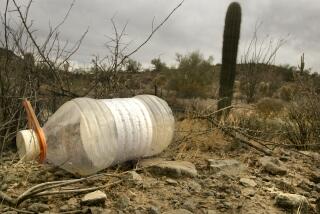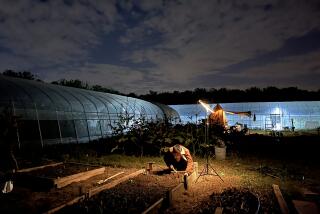Progress Hems In Nomadic Herders of Tibet
- Share via
DAMSHUNG, Tibet — For centuries, change came only with the seasons to Tibet’s alpine grasslands, painted rusty yellow in winter and emerald green in summer.
Yaks and sheep roamed free in lush pastures more than two miles high. As the chill of winter neared, nomadic herders moved the animals into the valleys through mountain passes festooned with colorful prayer flags.
These days, barbed-wire fences surround the beasts, and a yak sperm bank has opened for business.
A far-reaching policy designed to protect grasslands and improve the nomads’ livelihoods is bringing rapid change to Damshung, a county of pastures in the foothills of the snowcapped Thangla mountains.
“I’m not a big believer in ‘zoo culture,’ ” said Melvyn Goldstein, a Tibet expert at Case Western Reserve University in Cleveland. “I don’t believe that Tibetan nomads should be the same as they were in 1959 any more than farmers in Ohio should be the way they were in 1900.”
But the economic development initiative, launched by the Beijing government a decade ago in other range-land areas of China and about a year ago in parts of Tibet, has raised serious questions about what is best for Tibet’s unique culture and natural environment.
Many pro-independence Tibetans see the policy, which uses technology and improved infrastructure to encourage a shift from subsistence herding to industrial livestock production, not only as bad for the environment but also as an assault on the foundation of Tibetan identity and culture.
“The nomadic instinct to move from one place to another is in our psychology and culture,” said Thubten Samphel, a spokesman for the Tibetan government in exile in Dharamsala, India. “This mobility is indicative of the freedom of the open spaces of Tibet.”
China and Tibet maintained complex relations for centuries, but in 1950, the new Communist government in Beijing sent troops into Tibet and claimed sovereignty over the region. After an abortive uprising, Tibet’s traditional government, headed by the Dalai Lama, fled into exile in 1959.
Chinese officials blame the nomads’ “unscientific” herding methods for a degradation of the grasslands that make up 70% of Tibet. Grass yields per unit of land are down, they argue, noxious weeds are replacing usable grasses, and soil erosion is spreading.
Critics of the government also see degradation, but instead blame official policies and mismanagement.
One thing that is not in question is the singularity of Tibet’s environment. Scientists widely agree that the region’s high-altitude pastureland is one of the world’s important ecosystems, like tropical rain forests or arctic tundra, which should be preserved as a functioning habitat.
The Tibetan plateau covers 850,000 square miles, accounting for one-quarter of China’s total land area. Like America’s Great Plains, Tibet’s grasslands have supported and benefited from the grazing of large animals. Wild yaks, asses, gazelles and antelopes unique to Tibet still roam the area, although in decreasing numbers.
In Damshung, which means “chosen valley” in Tibetan, 90% of the county’s 36,000 inhabitants are drokpa, or nomadic herders.
Under the new policy, nomad families sign long-term contracts to use plots of state-owned land, which are sized according to the family’s number of animals and the land’s estimated capacity for supporting livestock.
The government encourages them to build houses and barns to replace their traditional yak-hair tents, and pays part of the cost of putting up barbed-wire fences to enclose each plot.
“Having the enclosures is good because it ensures that grass for the animals to eat in springtime will be protected,” Losang, a herder and mother of three, said as she doled out bowls of rich homemade yogurt for guests.
With a herd of 11 yaks, 17 sheep and six goats, Losang’s family lives below the local poverty line, getting by on $121 to $242 a year. The family sells the animals for grain or slaughters five or six sheep at their fattest in summer and then sells the meat in Lhasa.
Concentrating nomads in permanent settlements also enables the government to provide more social services, from roads and health clinics to schools and electricity.
Five years ago, before the new initiative got underway, Losang and her family built their first house, with wooden beams, an earthen floor and a low wall surrounding a yard. They got electricity last year, and their first television, recently purchased, sits on a shelf near pictures of Tibetan Buddhism’s highest clerics, the Dalai Lama and the Panchen Lama.
Although nomads have generally welcomed new houses and fences for their winter pastures, “not all the nomads accept the new policies,” said Chungda, the government’s second in command in the county. “But their concepts are gradually changing.”
Nomads have especially balked at officials’ insistence that they “rationalize” their herds by selling or slaughtering more animals, turning them into cash or food as insurance against the vicissitudes of the environment. Damshung also runs a sperm bank that tries to breed bigger, healthier yaks.
One local nomad says he slaughters as few animals as possible--just enough to enable him to survive or give to family members in need. He earns extra income by selling salt and yak butter.
“I feel pity for the animals,” he said. “I have enough of everything for myself, and I’m satisfied.”
That viewpoint reflects the Tibetan nomads’ traditional aim of maximizing herd size, motivated partly by Buddhist compassion for the animals but also as a survival tactic.
In Tibet’s harsh environment, heavy snowfalls and periods of severe cold often destroy large parts of herds and plunge nomads into poverty. In the winter of 1997-98, for example, 3 million livestock were lost in Tibet, as much as 70% of the animals in some townships. Nomads take years to rebuild their herds after disasters like this.
Mobility and herd diversity have traditionally been nomads’ keys to surviving these conditions by evenly allocating animals to grasslands and taking advantage of local variations in climate and vegetation.
Many nomads have traditionally had home bases in the valleys, where they spend two-thirds of the year. In summer, they move their herds into the mountains to let their winter pastures regrow.
In the past, nomads divided pastureland among clans--which had strict rules governing when, where and for how long herds could graze--and nomads who violated the rules could be fined.
Some experts say that outsiders fail to acknowledge the wisdom and sophistication of Tibetans’ traditional livestock management, which has allowed nomads to thrive for centuries.
“Simply focusing on pasture or livestock development fundamentally ignores the tight linkages between culture and the land,” wrote Wu Ning, an expert on range land at the Chengdu Institute of Biology, in a recent article.
Critics of the policy oppose curtailing nomads’ mobility and say that fences could spark conflicts over access to water and could hinder the migration of wild animals.
The massive investment in fences and artificially seeded pastures could place financial burdens on officials and herders--who share the costs--without any certainty of returns, critics add.
Markets cannot be created by fiat and, until they develop, the critics contend, Tibet will be ill-suited to the commercial ranching found in capitalist economies.
“I think that scientifically, it’s a bit dubious that there is tremendous pressure from overstocking and overgrazing,” said Goldstein, whose studies in Tibet have found excess grassland capacity. He said he suspects that some Chinese statistics on increasing numbers of animals are inaccurate and constitute a flimsy justification for the new policies.
“In the past, we seldom went down to the local level to survey the situation. We just sat in our offices and made up figures to report to the Tibet Autonomous Region authorities,” admitted a retired official in Lhasa, the Tibetan capital, in charge of agriculture and livestock policies.
Many variables in the debate remain unknown, including climate change. Chinese meteorologists say global warming might be responsible for higher temperatures and less rainfall on the Tibetan plateau.
While nomads in other areas, including Africa and the Eurasian steppes, have been pushed into increasingly inhospitable lands by advances in irrigation and agriculture, Tibetan nomads continue to thrive in the same harsh environment where their pastoralism developed centuries ago.
Yet the nomads are widely misunderstood, and experts say outsiders still harbor many misconceptions about them. One is that they are constantly on the move. In fact, many stay at their home bases for all but a few months of the summer grass-growing season.
The two or three times that they break camp and move each year, nomads pile their tents and belongings on yaks’ backs in an hour or two. Most treks between summer and winter pastures are no more than 40 miles, or a day on horseback. Because livestock spend most of their time grazing and putting on fat for winter, nomads avoid when possible long treks that burn animals’ calories.
Despite some Westerners’ shock at the modern world intruding on Tibet’s idyllic grasslands, many of the nomads are happy to see their standards of living improve.
But one nomad who has become a prosperous businessman observed: “Nomads are very conflicted about whether or not to come down from the mountains and live a more settled life. Some young people find the traditional lifestyle boring.”
Having chosen a more modern lifestyle, he still feels conflicted, but knows there’s no going back.
“At first, I felt superior to my friends at home. I had flown in airplanes and seen big cities,” he recalled. “But when I returned home, I discovered that although they had nothing, they were extremely happy, while my new life was filled with many worries.”
More to Read
Sign up for Essential California
The most important California stories and recommendations in your inbox every morning.
You may occasionally receive promotional content from the Los Angeles Times.













